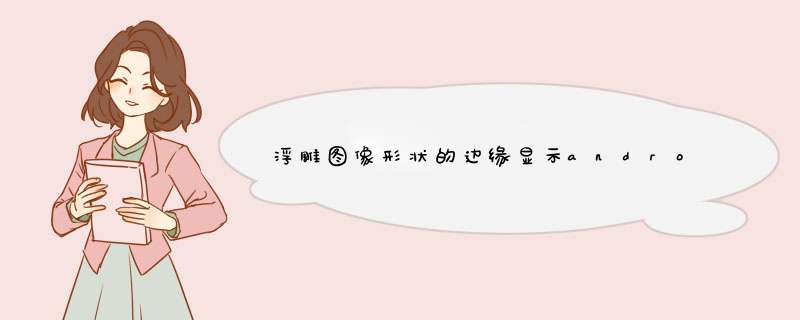
要求的输出
我的输出
Path path2 = new Path();public Paint fillPaint = null;// called in constructorpublic voID createPath(){ //path 2 Big one araay = new Point[]{new Point(144,320),new Point(109,200),new Point(171,308),new Point(178,240),172),282),new Point(144,160)}; AddBezIErs(path2,araay,320,144); Addline(path2,216,144 ); Addline(path2,216 ); Addline(path2,144,320); MaskFilter memboss = new embossMaskFilter(new float[] { 1,1,1 },0.4f,6,3.5f); fillPaint = new Paint(Paint.ANTI_AliAS_FLAG); fillPaint.setcolor(color.WHITE); fillPaint.setFlags(Paint.ANTI_AliAS_FLAG | Paint.DITHER_FLAG); fillPaint.setAntiAlias(true); fillPaint.setDither(true); fillPaint.setstrokeJoin(Paint.Join.ROUND); fillPaint.setstrokeCap(Paint.Cap.ROUND); fillPaint.setStyle(Paint.Style.FILL); paint.setMaskFilter(memboss); } // add lines to the pathprotected Path Addline(Path path,int endX,int endY) { //path.moveto(startX,startY); path.lineto(endX,endY); return path;}// add curves to the pathprotected Path AddBezIErs(Path path,Point[] points,int lastX,int lastY) { if (points[0].X != lastX && points[0].Y != lastY) path.moveto(points[0].X,points[0].Y); int index = 1; path.cubicTo(points[index].X,points[index].Y,points[index + 1].X,points[index + 1].Y,points[index + 2].X,points[index + 2].Y); index = index + 3; path.cubicTo(points[index].X,points[index + 2].Y); return path;}//draw on canvas@OverrIDepublic voID onDraw(Canvas canvas) { canvas.drawPath(path2,fillPaint); super.onDraw(canvas);}解决方法 如果您只想进行位图处理(而不是3D或矢量),最好的选择可能是: >从你的拼图中生成一个模板面具,
>使用Difference of Gaussians来处理它(在本例中我使用了大小为12和2像素的内核),然后标准化并反转结果,
>使用掩模(1.)作为模板通道,将“2”的输出混合到原始图像中.
更新:这里是代码.我试图重用你的变量名,以便更容易理解.代码尽可能使用Renderscript内在函数,以使事情更快,更有趣.
private Paint fillPaint = null;private Path path2;private Bitmap mBitmAPIn;private Bitmap mBitmapPuzzle;private RenderScript mRS;private Allocation mInAllocation;private Allocation mpuzzleAllocation;private Allocation mCutterallocation;private Allocation mOutAllocation;private Allocation mOutAllocation2;private Allocation mAllocationHist;private ScriptIntrinsicBlur mScriptBlur;private ScriptIntrinsicBlend mScriptBlend;private ScriptIntrinsicHistogram mScriptHistogram;private ScriptIntrinsicLUT mScriptLUT;private Context ctx;private int bw = 780;private int bh = 780;private voID init(){ mBitmAPIn = loadBitmap(R.drawable.cat7); // background image mBitmapPuzzle = Bitmap.createBitmap(bw,bh,Bitmap.Config.ARGB_8888); // this will hold the puzzle Canvas c = new Canvas(mBitmapPuzzle); path2 = new Path(); createPath(5); // create the path with stroke wIDth of 5 pixels c.drawPath(path2,fillPaint); // draw it on canvas createScript(); // get renderscripts and Allocations ready // Apply gaussian blur of radius 25 to our drawing mScriptBlur.seTradius(25); mScriptBlur.setinput(mpuzzleAllocation); mScriptBlur.forEach(mOutAllocation); // Now apply the blur of radius 1 mScriptBlur.seTradius(1); mScriptBlur.setinput(mpuzzleAllocation); mScriptBlur.forEach(mOutAllocation2); // Subtract one blur result from another mScriptBlend.forEachSubtract(mOutAllocation,mOutAllocation2); // We Now want to normalize the result (e.g. make it use full 0-255 range). // To do that,we will first compute the histogram of our image mScriptHistogram.setoutput(mAllocationHist); mScriptHistogram.forEach(mOutAllocation2); // copy the histogram to Java array... int []hist = new int[256 * 4]; mAllocationHist.copyTo(hist); // ...and walk it from the end looking for the first non empty bin int i; for(i = 255; i > 1; i--) if((hist[i * 4] | hist[i * 4 + 1] | hist[i * 4 + 2]) != 0) break; // Now setup the LUTs that will map the image to the new,wIDer range. // We also use the opportunity to inverse the image ("255 -"). for(int x = 0; x <= i; x++) { int val = 255 - x * 255 / i; mScriptLUT.setAlpha(x,255); // note we always make it fully opaque mScriptLUT.setRed(x,val); mScriptLUT.setGreen(x,val); mScriptLUT.setBlue(x,val); } // the mapPing itself. mScriptLUT.forEach(mOutAllocation2,mOutAllocation); 让我们休息一下,看看到目前为止我们有什么.观察到左边的整个图像是不透明的(即包括拼图外面的空间),我们现在必须正确地剪切其边缘的形状和抗锯齿.不幸的是,使用原始形状不起作用,因为它太大而且切得太多,导致边缘附近出现令人不快的伪影(右图).
因此,我们绘制了另一条路径,这次是使用更窄的行程……
Bitmap mBitmapCutter = Bitmap.createBitmap(bw,Bitmap.Config.ARGB_8888); c = new Canvas(mBitmapCutter); path2 = new Path(); createPath(1); // stroke wIDth 1 c.drawPath(path2,fillPaint); mCutterallocation = Allocation.createFromBitmap(mRS,mBitmapCutter); // cookie cutter Now mScriptBlend.forEachDstIn(mCutterallocation,mOutAllocation);
…为了更好看的结果.我们用它来掩盖背景图像.
mScriptBlend.forEachMultiply(mOutAllocation,mInAllocation); mInAllocation.copyTo(mBitmapPuzzle);}
你好!现在只是Renderscript设置代码.
private voID createScript() { mRS = RenderScript.create(ctx); mpuzzleAllocation = Allocation.createFromBitmap(mRS,mBitmapPuzzle); // three following allocations Could actually use createSized(),// but the code would be longer. mInAllocation = Allocation.createFromBitmap(mRS,mBitmAPIn); mOutAllocation = Allocation.createFromBitmap(mRS,mBitmapPuzzle); mOutAllocation2 = Allocation.createFromBitmap(mRS,mBitmapPuzzle); mAllocationHist = Allocation.createSized(mRS,Element.I32_3(mRS),256); mScriptBlur = ScriptIntrinsicBlur.create(mRS,Element.U8_4(mRS)); mScriptBlend = ScriptIntrinsicBlend.create(mRS,Element.U8_4(mRS)); mScriptHistogram = ScriptIntrinsicHistogram.create(mRS,Element.U8_4(mRS)); mScriptLUT = ScriptIntrinsicLUT.create(mRS,Element.U8_4(mRS));} 最后onDraw():
@OverrIDeprotected voID onDraw(Canvas canvas) { canvas.drawBitmap(mBitmapPuzzle,fillPaint); super.onDraw(canvas);} Todo:检查其他中风杆是否会给出更舒适的角落.
总结以上是内存溢出为你收集整理的浮雕图像形状的边缘显示android中的深度全部内容,希望文章能够帮你解决浮雕图像形状的边缘显示android中的深度所遇到的程序开发问题。
如果觉得内存溢出网站内容还不错,欢迎将内存溢出网站推荐给程序员好友。
欢迎分享,转载请注明来源:内存溢出

 微信扫一扫
微信扫一扫
 支付宝扫一扫
支付宝扫一扫
评论列表(0条)